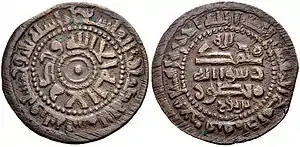Fals
The fals (Arabic: فلس, romanized: fals, plural fulus) was a medieval copper coin first produced by the Umayyad caliphate (661–750) beginning in the late 7th century. The name is a corruption of follis, a Roman and later Byzantine copper coin. The fals usually featured ornate Arabic script on both sides. Various copper fals were produced until the 19th century. Their weight varied, from one gram to ten grams or more.

A fals minted in Damascus between 696 and 750

Fals of Mansur ibn Nuh, minted in Bukhara, AH 353 (964 CE), commemorating the Abbasid caliph al-Muti
The term is still used in modern spoken Arabic for money, but pronounced 'fils'.[1] It is also absorbed into Malay language through the word fulus فولوس.[2]
In popular culture
- The Malay derivant fulus was used as basis for naming the fictional setting of Metrofulus in the 2006 Malaysian superhero film Cicakman.
See also
Daughter currencies:
References
- Stephen Album, Checklist of Islamic Coins, Santa Rosa, CA, 2011, third edition, p. 7
- "fulus". Kamus Dewan (4th ed.). Dewan Bahasa dan Pustaka Malaysia. Retrieved 6 September 2020 – via Pusat Rujukan Persuratan Melayu.
This article is issued from Wikipedia. The text is licensed under Creative Commons - Attribution - Sharealike. Additional terms may apply for the media files.
